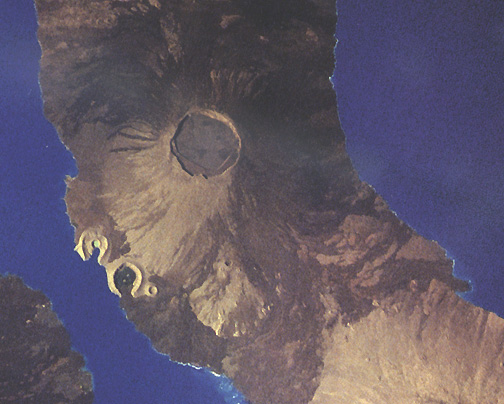|
Description of the Galapagos Islands Volcan Darwin  | | A view from space. Picture source: http://www.geo.cornell.edu/geology/GalapagosWWW/GalapagosGeology.html |
Volcan Darwin is the second volcano south on Isabela, located between Volcan Wolf to the north and Volcan Alcedo to the south. It is nearly perfectly symmetrical and rises to an elevation of 1325 m (4350 feet) and is the fifth highest volcano in the Galapagos. Like the other western volcanos, it has a large central caldera, nearly 5 kilometers (3 miles) in diameter and 200 m deep (700 feet). A number of young lava flows may been seen within the caldera, as well as on the flanks of the volcano. The primary eruption patterns seems to be from circumferential fissures surrounding the summit caldera, though radial fissures are also apparent. There are no confirmed historic eruptions of Volcan Darwin, but an 1801 eruption in "central Isabela" witnessed by Amasa Delano from anchorage in James Bay on Santiago could have been Volcan Darwin (Alcedo is the other possibility). Nevertheless, many of the lavas are quite young and no more than a few hundred years old, thus Volcan Darwin certainly remains an active volcano.
Two young pyroclastic cones, Tagus Cone and Beagle Cone, are located at the shore on the west flank of the volcano. Tagus Cone is partially breached and forms and excellent anchorage known as Tagus Cove, which has been a favorite stopping place for centuries. In the last century, whaling ships would anchor there to supplement their provisions with tortoises. Tortoises were particularly favored because they could be kept alive in the holds of ships for months without water or food. The Beagle anchored there in 1835 and Darwin spent considerable time exploring the area. Today, Tagus Cove is one of the common tourist stops in the western Galapagos.
Pyroclastic cones located near the shore, called littoral cones, such as Tagus and Beagle Cone, are common in the Galapagos. Darwin was the first to recognize that these cones form when basaltic magma comes in contact with seawater. When this occurs, the water is flashed to steam, and the magma fragments in to small ash particles that react with the steam to form palagonite, the light colored material of which the cones are composed. The entire process is quite explosive, and the ash is thrown into the air. It settles back to build a cone around the vent.
Like the other large western volcanos, much of the surface of Volcan Darwin is covered by aa lavas. Aa lava surfaces are extremely rough and much more difficult to walk on than the other type of lava surface, pahoehoe. Some lavas flows begin as pahoehoe but convert to aa when flowing down steep slopes. The characteristic steep slopes of the western Galapagos volcanos is why aa lavas predominate.
Tagus Cove is one of the many excellent localities to see Galapagos wildlife, particularly the abundant sea birds. Among those that may be seen here are the brown pelican and the blue-footed boobie. The vegitation in the area is typical of that in the dry lower elevations in the Galapagos, and include the unusual Palo Santo trees. These white-barked dwarf trees are leaveless and all but dead most of the year. They leaf out and spring back to life in the short wet season, which usually begins in March or April. The Darwin race of giant tortoises is usually found in the moister highlands, but females sometimes come down to the Tagus Cove area to nest.
Volcan Darwin was investigated in 1986 by a team of geologists from the University of Oregon and Cornell University.
|







